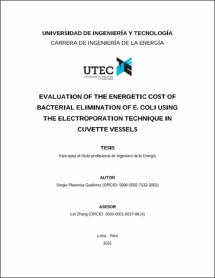Evaluation of the energetic cost of bacterial elimination of E. Coli using the electroporation technique in cuvette vessels
Resumen
In the last two years, the percentage of cases in Peru linked to diarrheal diseases in children has been considerably reduced, demonstrating that even in difficult times health must always be our greatest strength. Of course, fulfilling this desire requires that all Peruvians have access to treated water sources to comply with their personal hygiene duties. However, nearly 3 million Peruvians live without access to drinking water and leave their health to the fate of natural water sources with high probabilities of containing bacteria and viruses. Under this premise, the purpose of this thesis was to show the effectiveness of an alternative water sterilization treatment that could be of great help to these Peruvians in need. A methodology based on the 'electroporation' technique was developed through the application of low and high intensity electric field pulses, seeking to damage the cell membrane of Escherichia coli (E. coli) bacteria and inactivate their growth in contaminated water volumes. The E. coli cell was cultured in the laboratories of the University of Engineering and Technology and diluted in 9 ml of tap water to form a theoretical suspension of 480 CFU/ml of water. To meet the objective, pulses of 1, 5, 6, 10 and 15 kV/cm were applied to the contaminated water through cuvettes (400 μl) and the percentage of bacteria surviving the treatment was documented using the colony counting technique in Petri dishes. Respective measurements of pH, absorbance, and temperature of the water samples, as well as electrical measurements of the cuvettes, were performed moments before and after the application of the pulses. With this it was concluded that 1 kV/cm was sufficient to inactivate between 50-70 % of E. coli colonies when unipolar type pulses are applied in a time range of 20-22 μs. The minimum energy required to meet this result was simulated using MATLAB software and was 0.06092 J. This study did demonstrate that electric field is an effective physical phenomenon capable of sterilizing tap water samples using cuvette containers.


